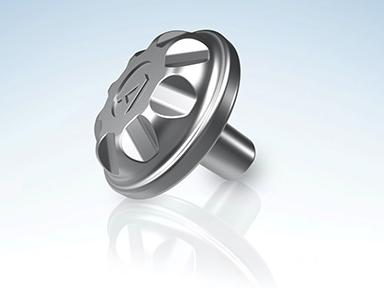
Posted to News on 15th Jun 2022, 12:00
Friction element welding in lightweight automotive manufacture

As a result of the growing use of lightweight metals and various high-performance steels the fastening technology industry faces fresh challenges. According to Arnold Umformtechnik, it is an area in which friction element welding is gaining increasing ground.
The manufacture of car bodies in particular calls for more intensive use of high-performance materials. While this provides a better choice of materials and composites, the focus is now on which fastening solution to use – especially where aluminium and high-strength steel in strengths above 1000 MPa need to be joined together.
One method of joining these two materials is friction element welding. Arnold Umformtechnik is making increasing use of this assembly method for multi-material combinations. “With friction element welding, we have expanded our product range with the aim of offering our customers services for every aspect of car body construction – even joining lightweight sheet-metal to high-strength steels,” explains Emanuel Heinle, head of R&D for fastening systems at the company.
The friction element welding process uses an element to join an aluminium sheet to high-strength sheet steel, as one example. The method uses the frictional heat that develops from the friction between the welding element and the high-strength steel.
The process consists of four steps. In the first step, the hold-down device is positioned onto the component, pressing the two metals together. The tip of the element is positioned on the aluminium cover sheet. The second step consists of penetrating this sheet. The fastener is applied at a set rotational speed and axial force, thus penetrating the aluminium cover sheet. The sheet becomes hot and softens.
At the same time, the fastener displaces the cover sheet against the direction of assembly. Once the fastener has completely penetrated the cover sheet and made contact with the high-strength steel, the third stage can begin – the friction. The surface of the sheet steel is mechanically cleaned and the friction heats up the welding area. The sheet steel and the fastener both soften at this point. And as a result, the fastener is shortened.
Once it has sufficiently shortened, the last stage of the process begins – upsetting. The rotational speed is reduced to zero and the welding area is upset with high axial force while it cools down. The sheet steel and the fastener form a firmly bonded friction weld connection and the cover sheet is fastened in a positive and load-carrying connection between the steel sheet and the head of the fastening element.
“The biggest unique selling point for friction element welding is that the method can be used for high-strength sheet metals over 1000 MPa in strength,” says Heinle. “Few solutions in vehicle manufacturing can be used overall to join high-strength steel and an aluminium sheet.”
In terms of steel material, there is no strength limit. All that is necessary, depending on the thickness of the sheet, is to make sure that the materials can soften reliably during the friction process. According to Heinle, accessibility from both sides is also required. Since the direction of assembly is always from aluminium to steel, the fastener must be applied from the aluminium side. “In principle, the method is suitable for joining lightweight metals to high-strength steel,” he says. “There’s no need to pre-form holes, and the method produces a very high-strength fastening.”
Friction element welding is appropriate for example in the production of car components such as the passenger compartment, which would suffer enormous stress in a crash situation, and the components used must therefore be guaranteed high-strength.
The joint always consists of a base or foundation sheet consisting of high-strength steel, with a cover sheet of aluminium or other lightweight metal material. The process can be used for high-strength steels such as hot-formed 22MnB5 steel. The sheet thickness for the base sheet can range from approximately 0.80 mm to 2.00 mm, and the aluminium sheet can be between 1.00 and 3.00 mm thick.
As an example, Arnold Umformtechnik, working with BMW, has developed a proprietary fastener for friction element welding. It is distinctive for several engineering design characteristics:
- The drive is designed to ensure that axial force and rotational speed can be optimally transferred
- The element’s flange ensures that the head setting offers very little opportunity for corrosion to get a grip
- The head undercut enables space for the material rising from the cover sheet, which means that the head contacts the sheet
- The shaft has sufficient material to penetrate the cover sheet and, with the friction, to generate a welded joint
- The tip geometry is characterised by its wave-like indentations that create the necessary stability during the process, while also reducing the necessary axial force
System technology tailored to the process
The technology designed especially for this process has been developed by Harms and Wende of Hamburg, in collaboration with BMW. Collaborative work between Arnold Umformtechnik and Harms and Wende resulted in the two companies now jointly marketing this technology system. For the fastenings specialist from Forchtenberg this collaborative work also means that they can offer a complete system to their customers, including service.
The system itself consists of a feeder unit, a joining unit and the control cabinet. The system is distinctive from its competitors in that there is a greater range of assembly parameters. These include the down-holding force, the axial force and the rotational speed; thus, the down-holding force range is up to a maximum of 4.00 kN, the axial force up to 10.00 kN, and the rotational speed up to 25,000 rpm.
The joints can be checked using both destructive and non-destructive inspection techniques. A chisel test with a forked chisel is a quick method, followed by an evaluation of the fracture pattern. Tensile shear tests and cross tension tests are used to determine strength. And it is possible to visualise the welding spot as a significant analysis criterion on the metallographic microsection by etching its surface.
The first projects carried out by customers using this method indicate that friction welding has its place in automotive lightweight construction. BMW is already using the technology, and other automotive manufacturers and suppliers are also interested.
This method offers a multitude of advantages for Arnold Umformtechnik customers. The material combination meets the high stability and fastening strength requirements in car body constructions. There is no need for any preparatory steps such as decoating, cleaning or pre-drilling holes. The chipless process can also be used with narrow flange widths. Moreover, the friction element welding process stands out for its short cycle times, an uncomplicated assembly program and the wide range of the process window.









